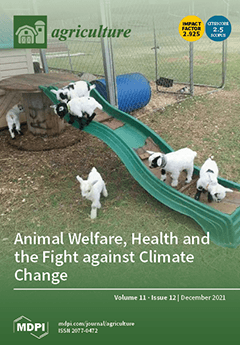To ensure sustainable agricultural production and protection of crops from various biotic and abiotic stresses, while keeping in view environmental protection, by minimal usage of chemicals, the exploitation of beneficial microorganisms and modern nanotechnologies in the field of agriculture is of paramount importance. This study aimed to investigate the effects of
Serendipita indica and guanidine-modified nanomaterial on the growth, and other selected parameters, of cabbage, as well as incidence of black spot disease.
S. indica was applied in substrate and by seed inoculation.
S. indica had a positive impact on the development of plants, and resulted in reduced black spot severity. The maximum plant height (119 mm) and number of leaves (8.3) were observed in
S. indica-treated plants. Pigments were enhanced, i.e., chlorophyll
a (0.79 mg/g), chlorophyll
b (0.22 mg/g), and carotenoid content (0.79 mg/g), by substrate treatment. The highest antioxidant capacity (9.5 mM/L), chlorophyll
a and
b (1.8 and 0.6 mg/g), and carotenoid content (1.8 mg/L) were reported in
S. indica seed treatment.
S. indica treatment resulted in 59% and 41% disease incidence decrease in substrate and seed treatment, respectively. Guanidine-modified nanomaterial was seen to be effective in improving plant growth and reducing disease incidence; however, it did not perform better than
S. indica. Application of nanoparticles resulted in enhanced normalized difference vegetation index and fluorescence by increasing chlorophyll
a,
b, and carotenoid content. Nitrogen content was the highest in plants treated with nanoparticles. However, the effect of the combined application of fungus and nanoparticles was similar to that of
S. indica alone in substrate treatment, although negative impacts were reported in the biochemical parameters of cabbage.
S. indica has great potential to enhance plant growth and manage
Alternaria incidence in cabbage crops.
Full article





